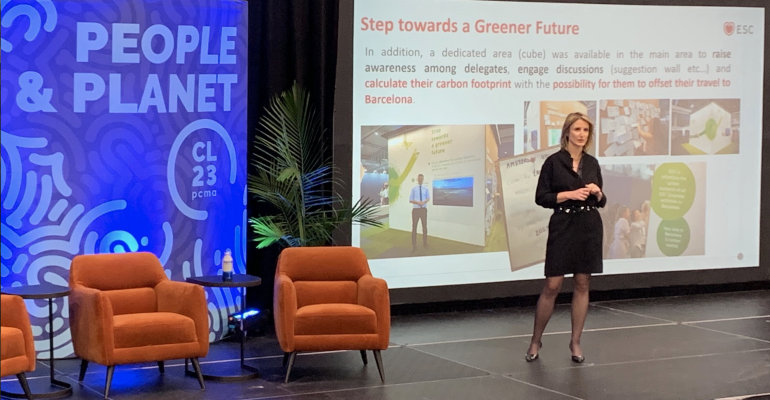When the European Society of Cardiology decided that its 2022 annual meeting would be carbon neutral, its planners knew there would be a lot of work to do. But they didn’t think that one of the toughest tasks they’d face would be getting buy-in from attendees.
The plan to make the annual meeting carbon neutral started with the association hiring an environmental consulting firm to measure the carbon emissions associated with every part of the on-site activity. Anne-Laure Leuba, director of specialty congresses for ESC, says that the total came to roughly 4,000 tons of carbon.
From there, she and her team set out to make changes in different areas to reduce carbon emissions. Those changes included eliminating the printed program of nearly 600 pages in lieu of a mobile app. Although “our attendees always said they want the program in printed format, we made the switch and got only a handful of complaints from among the 20,000 attendees,” she says. Another change: Going to recycled carpeting in the exhibit hall, which is effective but comes at greater expense.
When those and other opportunities were exhausted, the association chose to invest in several carbon-offset projects around the world to bring the on-site event elements to a net-zero carbon rating. The cost for those offsets: about $60,000.
To recoup that expense, ESC decided to go the voluntary route with its attendees. First, the association placed eye-catching informational cubes in the registration area and around the exhibit hall that showed attendees the elements related to their individual carbon emissions from the event. Then, a booth was placed outside the entrance to the exhibit hall where attendees could pay $22 that would go towards the carbon offsets the association purchased for the conference.
While the informational cubes did get a lot of attendee views, according to ESC’s Leuba, the financial result was shockingly poor: Only 20 attendees chose to pay the optional fee.
Lessons Learned
For its future events, ESC is expanding the ways it minimizes carbon emissions while considering a change in its approach to paying for carbon offsets.
Going forward, the association will only use destinations with ample rail service so that more attendees can travel by train rather than by plane. It will also add questions to its RFPs for convention centers and hotels that require details about their sustainability procedure and protocols, along with numbers to back up their claims. And on the exhibitor side, ESC will take a more active role in making sure that show booths are built and operated in sustainable ways.
As for recouping the costs of whatever offsets the association purchases—and to pay for offsets related to air travel to ESC shows, which produces about as much carbon emission as all the event activities on site—ESC might add a fee on the registration form that will be applied to carbon offsets. Leuba stresses that the purpose of the fee would be clearly explained on the form.
“It’s important to provide all the details around your sustainability efforts in the show’s marketing materials,” she says. It's also important to deliver a larger message that hopefully resonates with the audience: “A single leaf working alone provides no shade,” Leuba notes. “For such an initiative to succeed, there must be a shared vision between the event’s host and its participants.”
Don't miss a thing: Sign up for our e-newsletters HERE.
And join the industry conversation: Connect with us on LinkedIn.





